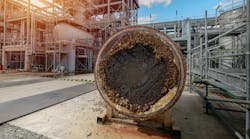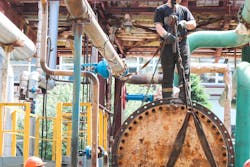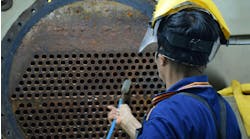A longstanding standard for identifying the fouling of heat exchangers appears to be outdated and insufficient for optimized system design and performance measurement.
Exchanger fouling, or the accumulation of unwanted materials, reduces heat-transfer effectiveness of heat exchangers. The fouling layer insulates the surface and reduces heat transfer rates. To get required duties, either the temperature driving force must increase or the exchanger must have more surface area. Identifying the amount of fouling and its heat-transfer effects is extremely difficult. For shell-and-tube exchangers, the Tubular Exchangers Manufacturers Association (TEMA) publishes tables that include Recommended Good Practice (RGP) values of fouling factors for use in exchanger design.Nevertheless, the responsibility for determining the expected effect of fouling lies with the user not the equipment provided. While TEMA values are available, the plant or operating company, not the equipment vendor, bears responsibility if use of TEMA fouling factor values creates a less-than-ideal design. After all, the plant has the most experience with specifics of the service and must live with the consequences of the exchanger operation.
TEMA Under Fire
A general criticism of the TEMA fouling values is that they were originally developed with very little, or perhaps even no data, to back up the values. The TEMA first edition was published in 1941. This standard listed minimum fouling factors to be used for recommended design. These were based on a consensus of experience from a variety of people but used no full analysis in deciding the fouling values.
Over the years, TEMA has changed to using RGP values. These are intended to balance energy, equipment, cleaning cycles and other costs to arise at a single value that approximates optimum performance. No detail on this balancing act is included. In fact, the fouling factors in use have changed very little from 1941 to today.
The use of TEMA values as an expectation has always had detractors. First, the fouling factor is supposed to represent problems in thermal performance related to only fouling. However, it is extremely difficult to directly measure the properties of a fouling layer in an exchanger. As such, the normal approach in the plant is to measure exchanger performance and attribute all differences between actual performance and calculated performance as the result of fouling. This means that the plant calculated fouling factor used to evaluate a basis includes the results of all errors and uncertainties in data, methods and system properties. (See “Don’t Rely on Hydraulic Capacity Regulations”). This confuses evaluation of tradeoffs in equipment and process design choices.
Unreliable Data Leads to Poor Designs
Using a too-high fouling factor causes the designer to add more surface to the exchanger. Against the common design constraint of a maximum pressure drop allowed, a larger exchanger has lower fluid velocity. Lower velocities nearly always increase fouling rates. Designing for high fouling creates the situation that causes high fouling. (See “More Exchanger Area Can Pose Pitfalls”).
Another problem that can occur when designing with a high fouling factor is that when the equipment is clean, metal surface temperatures may be very high. For vaporizing services, the higher surface temperature may change the exchanger operation from nucleate boiling to film boiling. This reduces the heat transfer rate (See “Equipment Performance: Consider Critical Heat Flux”). It looks like the exchanger is fouling, but what has happened is that the heat-transfer regime has changed. Again, the expectation of fouling leads to an oversized exchanger that performs with a low heat-transfer effectiveness.
Also, except for cooling water and crude oil, TEMA does not include any variation in the fouling factors for fluid velocity. Extensive experience shows that most services have lower fouling factors at higher velocity.
Old Problem, New Approaches
An approach that has arisen over the years is to use a no-fouling design (Gilmour 1965). This idea comes into and goes out of fashion over the decades. The exchanger is designed to operate at high fluid velocities (or shear stress) to prevent fouling. At the present, it’s mostly out of fashion. The challenge is that units have upsets, rate changes, operating changes and composition variations. What is intended to be an exchanger that shouldn’t foul often does foul at off-design conditions. And once it’s fouled, it has insufficient surface and can’t do the duty until it’s cleaned.
Despite the problems outlined, no consensus has emerged around what might be a more effective approach. The main contenders for alternates to fouling factors are the cleanliness factor or the over-surface approaches. The cleanliness factor is a value (less than 1) use to derate the prediction of an exchangers clean heat-transfer coefficient. The over-surface approach specifies that a certain amount of extra surface should be added to the exchanger. Conceptually, these are very similar but not identical. While the over-surface approach has supporters, TEMA’s latest edition (10th) explicitly calls this an “inappropriate approach to heat-exchanger design.”
That’s excessively strong wording, many people disagree with TEMA on this point. Nevertheless, no clear consensus has emerged to use alternate approaches to fouling factors. TEMA provides a useful starting place for fouling factors, but the final responsibility for selecting a fouling factor always rests on the operating plant. Let your experience guide the fouling specification for design.
References
GILMOUR, C. H., 1965. No fooling - no fouling. Chemical Engineering Progress. July 1965. Vol. 61, no. 7, p. 49–54.




